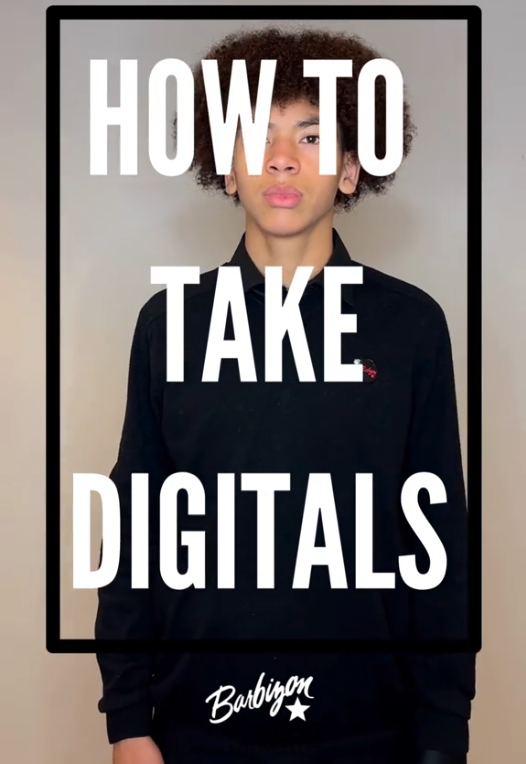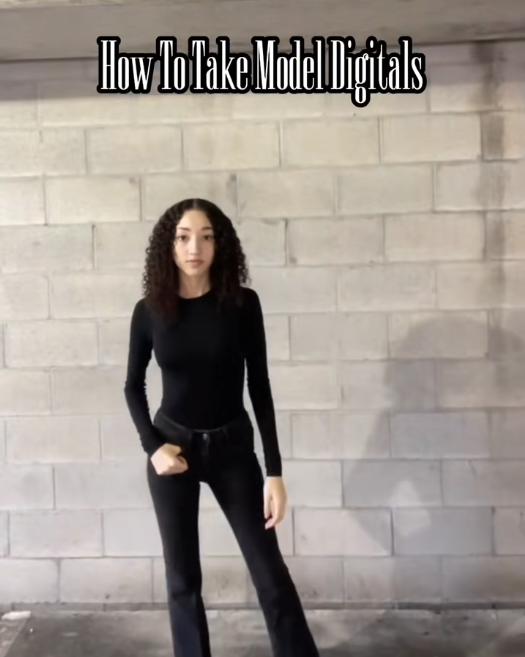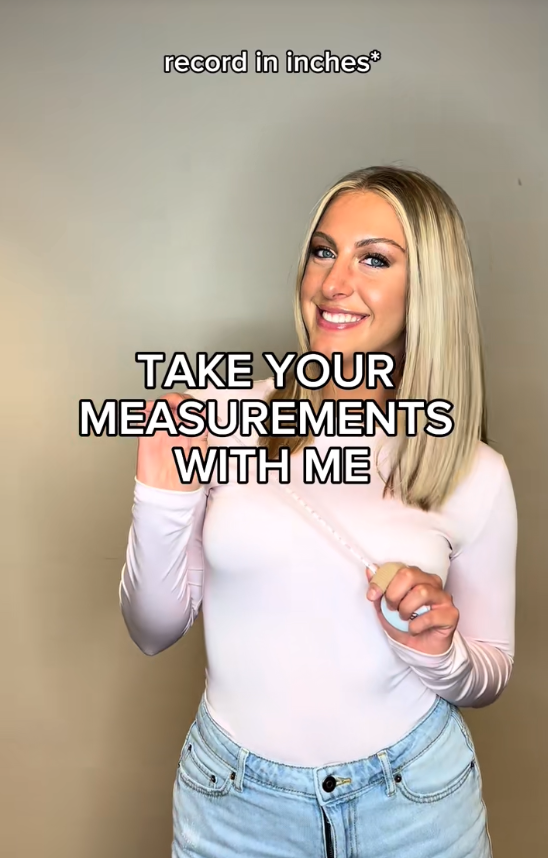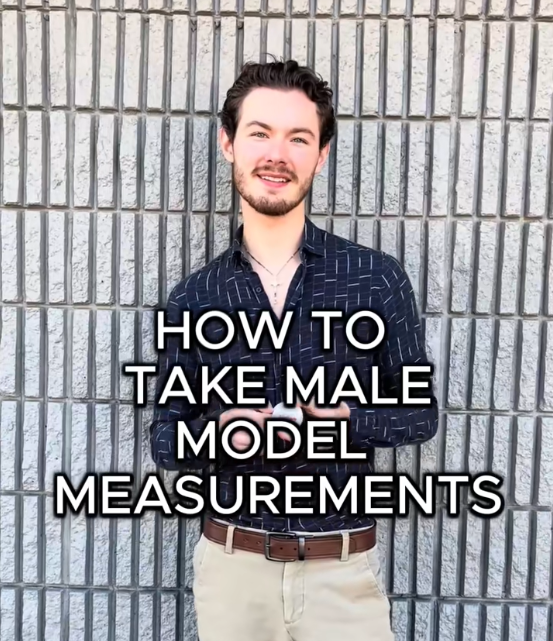Tips and Tricks
Below you will find some helpful information to expand your industry knowledge. Please email placement@barbizonusa.com if you have any questions.




Prepare the Digital Model/Actor Bag!
Digitals
Taking Digitals

On location Digitals

Modeling digitals are a collection of unedited/filtered photos that show a model's natural look. They are also known as modeling polaroids.
Purpose
- To give agencies and clients a realistic sense of what the model looks like
- To show a model's potential without distractions like heavy makeup or fancy clothing
How they are taken
- Typically taken against a white or neutral-colored background
- Use natural lighting - no flash or shadows should be in the photos
- Include a headshot, full body shot, profile shot, and 3/4 profile shots
How to prepare
- Get enough rest and stay hydrated
- Avoid sugary drinks to have a clear completion
- Practice facial expression techniques
- Wear simple, form-fitting clothing, generally all black or neutral colors (white top/blue jeans, etc.)
- Keep your expressions neutral
- Avoid fake nails, spray tans, lashes, and makeup - you can have minimal foundation to cover blemishes, lip balm, and light mascara
How often they are updated
- Every few months or if there are major changes to the model's look - braces, hair cut/color, tattoo, etc.
How to Self Tape
Self-tape video guide!
- First, read and review all instructions sent to you.
- Find a blank background to film in front of (no distractions in the background that take away from your performance)
- Try to film with the highest quality device that you have. Additionally, make sure that you are in a quiet place.
- They frame for the video should be mid-waist to an inch above the top of your head.
- Wear a vibrant, solid color t-shirt while recording such as red, blue, green, yellow etc. No prints, logos or patterns.
- Have someone read with you for dialogue. This reader should be clear but not overpowering your performance. This person is not auditioning.
- Try your best to memorize your lines. You can hold a copy, but it's not recommended.
SELF-TAPE SETUP:
*Please make sure you have good lighting and audio. *Please read eyeline directly to the camera. *Please say your name, age range/age and union status in slate *Please state where you’re based. *Please make sure to film on your phone horizontally/landscape. *Please be camera-ready as you will be going to an in-person audition and show your own personal style. PREPARATION FOR THE READ: *You must have good lighting and audio and film in a quiet location. *Film on your self-tape HORIZONTALLY-not vertically. *Film in front of a blank background. *Be camera-ready hair & make-up as you would be going to an in-person audition. *Just be yourself and have fun, we want to get a sense of your personality. DURING THE READ: *Slate your First and Last Name, Location, Union Status and Age/Age Range. Please give us a big smile! *Have the copy memorized and eyeline is off camera, do NOT look directly into the camera for Theatrical Auditions (unless it specifies breaking the 4th wall) .Personality Video
An actor personality video, also known as a personality slate, is a short video that showcases an actor's personality, talents, and versatility. It can be used to introduce an actor to potential casting directors/representation.
Purpose
- To highlight an actor's unique talents, personality, and versatility
- To introduce an actor to potential casting directors
- To showcase different characters
A modeling personality video, is a short video that catches a glimpse of your personality while having a video of your digitals and poses. It can be used to introduce an model to potential clients/representation.
Purpose
- To highlight a model's personality and on-camera presence
- To introduce a model to potential clients
- To showcase different poses/angles
How to take measurements


Things NOT to do at a Casting
- Don't chew gum.
- Bring your materials (sides, script, etc.) but do not look at them while auditing. If you need to read a line or two, that's fine. Try your best to have all materials memorized.
- Eye-contact is professional. Don't stare down the casting director while performing, but do be polite and make some eye-contact.
- Don't let your hair cover your face.
- Don't make excuses. Everyone makes mistakes. Just keep going.
- Don't forget your headshot.
- Don't be late.
- Don't bring guests. Children under the age of 14 years old can have one parent. Anyone else is unnecessary.
- Don't brag, gossip, coach or show off in the waiting area.
What to bring for a photoshoot
Model bag- Nude, black, and white undergarments
- Closed and open toe heels - black or nude colored
- Makeup kit
- Hair accessories
- Black bikini
- Basic outfit - jeans/shorts and a white tank
- Phone charger/headphones/book
- Snack and water/thermos
Tips for Posing
- BE CONFIDENCE
- Practice, practice, practice
- Practice your facial expressions in the mirror
- Know your angels
- Be natural
- Move when you hear the camera shutter click
- Use your limbs - include movement and poses with your arms/legs
- Use your accessories/surroundings - use your outfit, accessories, and props to add new dimension to your photos
- Don't be afraid to try new poses
- Play some music to get you in the zone
Industry Lingo
- Action: Begin the action or script
- A.D.: Assistant Director.
- AEA: Actors' Equity Association often called simply "Equity."
- Audition: A tryout for a film or TV role, usually in front of a casting director, for which a reading is required.
- Avail: A courtesy situation extended by an agent to a producer indicating that a performer is available to work a certain job. Avails have no legal or contractual status.
- Art Director: Person who conceives and designs the sets.
- Back To One: Taking it from the top of the same scene or moment of action you just did
- Billing: The order of the names in the title of opening credits of a film or TV show
- Blocking or Staging: The actual physical movements by actors in any scene.
- Blue Screen: Shooting in a studio against a large blue or green backdrop which allows background to be superimposed later on the final stage
- Booking: A firm commitment from a performer to do a specific job.
- Breakdown: A detailed listing and description of roles available for a casting in a production.
- Buyout: An offer of full payment in lieu of residuals, when the contract permits. No buyouts in perpetuity.
- Callback: Any follow-up interview or audition.
- Casting Director: The producer’s representative responsible for choosing performers for consideration by the producer.
- Commission: Percentage of a performer’s earnings paid to agents for services rendered.
- Credits: Performance experience listed in a resume, also opening names in a film or TV show.
- Cue: Hand signal by the Stage Manager
- Cut: Stop the action
- Day Out of Days: The schedule containing the work days for all actor or a film project.
- Day Player: A performer hired on a daily basis, rather than on a longer term contract.
- Dealer Commercial: A national commercial produced and paid for by a national advertiser and then turned over to a local dealer to book air time, usually with the dealer’s tag added on.
- Demo Tape: An audio or video that agents use for an audition purposes.
- DGA: Directors Guild of America
- Dialogue: The scripted words exchanged between performers
- Director: The coordinator of all the artistic and technical aspects of any production
- D.P (Director of Photography): Supervises all decisions regarding lighting, camera lenses, color and filters, camera angle set-ups, camera crew and film processing
- Double: A performer who appears in place of another performer, i.e. as in a stunt
- Downgrade: Reduction of a performer’s on-camera role from principal to extra
- Equity: Actor’s Equity Association
- Exclusively: Achieved by virtue of performing as a principal in a commercial. During the contractual period of payment the advertiser has exclusive rights to the performer’s work, likeness and image with regard to competitive products.
- Executive Producer: Person(s) responsible for funding the production
- Extra: Background talent used in non-principal roles.
- Field Rep: Union staff member who ensures contractual compliances on sets
- First A.D: First Assistant Director who is responsible for the running of the set. Gives instructions to crew and talent including calling for rehearsal, quite on the set, take five etc.
- First Refusal: A non-contractual courtesy situation extended to the producers by agents on behalf of the performers, giving the producer the “right” to decline to employ the performer before the performer accepts a conflicting assignment
- First Team: The production term for the principal actors on scene
- Fixed Cycle: For commercials, an established 13-week period for which the advertiser pays a holding fee to retain the right to use the performer’s services, likeness and image in a previously produced advertisement
- Forced Call: A call to work less than 12 hours after dismissal of the previous day. Also see Turnaround
- Foreign Replay: A fee paid for the re-runs outside the U.S
- 4-A’s: Associated Actors and Artistes of America, umbrella organization for AFTRA, SAG and other performers Unions.
- Franchised Agent: A talent agent approved by AFTRA or Sag to solicit and negotiate employment for their members.
- Freelancing: Working through more than one franchised agent rather than signing exclusively with an agent. Also, working for multiple employers as a performer, distinguished from permanent employment at a radio/TV station or network.
- Gaffer: In film, a crew member who moves set pieces or props
- Golden Time: Contractually called the 16 Hour Rule Violation for Extra Performers, is overtime, after the 16th hour, paid in units of one full day per hour
- Hand Model: A performer whose hands are used to double for others.
- Hold (On Hold): A contractual obligation for a performer to be available for work
- Holding Fee: Set payment by an advertiser to retain the right to use a performer’s services, image or likeness on an exclusive basis
- IATSE: International Alliance of Theatrical Stage Employees
- Improvise: Use your imagination to develop moments without scripted text
- Industrial: Non-broadcast, often education, films or tapes
- Lift: Process of taking a sequence from one commercial to create all or part of another commercial, sometimes called a “mechanical Lift”
- Line Producer: The producer who is responsible for keeping the director on time and budget. The Line Producer is usually the most visible producer on set.
- Liquidated Damages: Monetary penalties imposed on an employer when contract provisions are violated
- Looping: An in-studio technique matching voice and picture.
- Matching Actions: The requirement that the actor match the same physical movements in a scene from take to take, in order to preserve the visual continuity
- Mark: Designated spot actor must stand for the camera shot
- Meal Penalty: A set fee paid by the producer for failure to provide meals or meal breaks as specified by the contract.
- Monologue: A solo performance by an actor
- MOS (Motion Only Shot): Any shot without dialogue or sound.
- NABET: National Association of Broadcast Employees & Technicians
- Off-Camera (OC): Dialogue delivered without being on screen.
- P.A.: Production Assistant
- Paymaster: An independent talent payment service acting as the employer of record and signatory
- Pick Up: An added take because of a problem with a shot
- Pilot: The first show introducing the characters and situations for a potential series
- Principal: A performer with lines or special business which advances the story line
- Producer: Often called Line Producer, the person responsible for the day-to-day decision-making on a production
- Props: Easily moved object used in the course of action
- PSA: Public Service Announcement (needs approval of AFTRA/SAG)
- Residual: The fee paid to a performer for rebroadcast of a commercial, film or TV program
- Right to Work States: Those states which do not honor certain union provisions
- Rolling: The verbal cue for the camera film and audiotape to start rolling
- Scale: Minimum payment for services under Union contracts Scale + 10 - Minimum payment plus 10% to cover the agent’s commission, required in some jurisdictions for agents to receive commissions
- Script Supervisor: The crew member assigned to record all changes or action as the production proceeds
- Second A.D: There are often two or three on the set. They handle checking in with the talent, insuring proper paperwork is filed, distribute script revisions. Actors check in with the Second A.D upon arrival of the set
- Session Fee: Payment for initial performances in a commercial
- Sides: Pages or scenes from a script, used for auditions
- Signatory: An employer who has agreed to produce under the terms of a Union contract
- Slate: A small, chalkboard and clapper devise, used to mark and identify shots on film for editing; also, the process of verbal identification by a performer in a taped audition (e.g. “Slate Your Name”.)
- Station 12: At SAG, the office responsible for clearing SAG members to work
- Stand Ins: Extra players used to substitute for featured players, usually for purpose of setting lights
- Stage Manager: The person who oversees the technical aspects of an in -studio production
- Studio Teacher: Set teacher or tutor, hired to provide education to working young performers; also responsible for enforcing Child Labor Laws and minor’s provisions in the Union contracts
- Stunt Coordinator: The person in charge of designing and supervising the performance of stunts and hazardous activities
- Stunt Double: A specially trained performer who actually performs stunts in place of a principal performer
- Taft-Hartley: A federal statute which allows 30 days after first employment before being required to join a union
- Teleprompter: The brand name of a device which enables a broadcaster to read a script while looking into the lens.
- Turnaround: the number of hours between dismissal one day and call time the next day.
- Under 5 (U-5): In AFTRA contracts, a speaking role having 5 lines or less
- Upgrade: Acknowledgement by a producer that a player hired as an extra has performed principal work, resulting in principal payment
- Voice Over (VO): Off-camera dialogue
- Wardrobe: The clothing a performer wears on camera
- Wardrobe Allowance: A maintenance fee paid to on-camera talent for the use (and dry-cleaning)
- Wardrobe Fitting: A paid session held prior to production to prepare a performer’s costumes
- Wrap: Finishing a production
WANT TO LEARN MORE?
Call us at 1-800-330-8361
or visit our website at
www.barbizonmodeling.com
Recent Posts
Categories
FOLLOW BLOG VIA EMAIL
Enter your email address to follow this blog and receive notifications of new posts by email.
